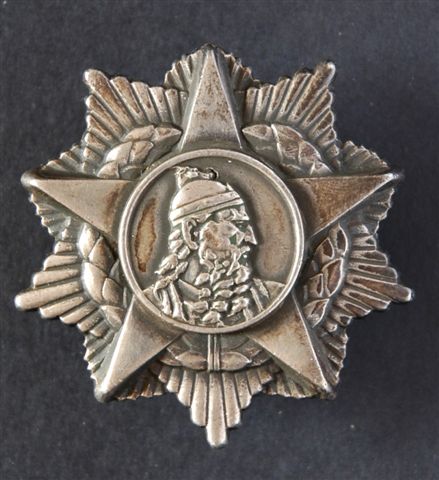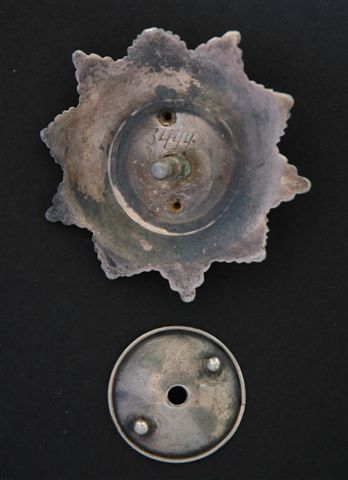-
Posts
1,147 -
Joined
-
Last visited
-
Days Won
12
Content Type
Profiles
Forums
Blogs
Gallery
Events
Store
Posts posted by Elmar Lang
-
-
Hello,
in my opinion, observing the type of pin on the reverse, I think that the badge should be post-1945, possibly to substitute the awards of the German Reiterabzeichen from III Reich distributed after tha Anschlu? of 1938.
Best wishes,
Enzo
0 -
Hello,
from what we can see after the interesting communication of Josef, the Kriegskreuz f?r Zivilverdienste is a relatively rare decoration in all its classes; rare/scarce in the 1st Class, of course.
The average price of the 2nd to 4th class is usually very moderate.
It is interesting to note that this decoration was produced also by the "Wiener Werkst?tte f?r Angewandte Kunst" a famous atelier where perhaps the best Vienna "Jugendstil" pieces have been produced. Such pieces are struck with the superimposed double "W" mark.
Best wishes,
Enzo
0 -
Poor soldiers!... Why should they receive their decorations and medals without ribbon?
Of course, the Kaiser's pocket money was enough to pay the costs of ribbons also for Other Ranks...
Best wishes,
Enzo
0 -
Try looking at the cross' rim; possibly, there's the maker's mark, like HMA, BSW, etc.
A very rare case; it won't very difficult to complete the set with its proper ribbon bar.
Enzo
0 -
An extremely fine and uncommon piece, especially for its full-size-like pinback mount. I congratulate!
Enzo
0 -
Yes, Austrian-style swords, but on a post-1938 (or post-Anschlu?) German-style ribbon bar, belonged to an officer serving in the Austrian 1st Republic, then in the Wehrmacht.
Enzo
0 -
Hello,
I would like to add two pictures of the numbered Skanderbeg III Class, recently added to my collection.
It is made of silver; its measurements are:
heigth: mm 48,0
width: mm 47,8
Award no. 3444.
Best wishes,
Enzo

 0
0 -
Hello,
Excellent contribution from Artan!
I've recently added to my Albanian collection a Skanderbeg III Class, with number "3444". Is there any chance to know something more about its recipent and date of award?
Best wishes,
Enzo (Elmar Lang)
0 -
Hello,
I think I need to do a deeper research but, in my opinion, ribbon bars have been introduced in Austria during WW1.
In earlier times, full-size decorations were usually worn also in field conditions.
Best wishes,
Elmar Lang
0 -
Hello,
I'm doing a research about a Blutorden awarded to an SS Officer.
The name is Reinhold Baumgartner, born on Dec. 16th, 1897 (in Saalfeld/Saale, Th?ringen), NSDAP membership number 289.772 and SS nr. 1.522.911. He received the SS Ring and was awarded with the Blutorden on Oct. 21st, 1939.
Would it be possible to know the award number of his Blutorden?
Many thanks in advance and best wishes,
Enzo
0 -
Hello,
an interesting question.
Actually, the right to wear Kriegsmedaille should have been extended to the war started in 1914 (Imperial Decision from Dec. 16th 1916, where the medal is called "Kriegserinnerungsmedaille"), with a different ribbon (yellow with a black stripe on one side, the other with a green-white-red stripe).
The Austrian Republican government, had the right to complete the award procedures, when started earlier that the armistice and abdication of the Emperor.
This could be the case of the posted "Legitimation".
Best wishes,
Enzo
0 -
Hello,
the owner of that ribbon bar (here of German type), was an officer for sure, since the first two decorations with swords can be attributed to the Milit?rverdienstkreuz III Klasse mit Schwertern and to the Bronzene Milit?rverdienstmedaille ("Signum Laudis") with Swords.
An NCO could have received only the Goldenes (Silbernes) Verdienstkreuz mit der Krone (ohne Krone): both, after 1914 were awarded with "war" ribbon and swords.
Best wishes,
Enzo
0 -
Hello Boris,
the strange ribbon has been wrongly attributed to the medal. Actually, the ribbon looks well post-1918 and with colours resembling those of the Order of the German Eagle.
"AC" is another latin form of the conjunction "ET", similarly with "ATQUE" where "atque" can mean "and also...".
The other medal, with the cyrillic text is the jubilee medal for the members of the Russian Kexholm Guards Regiment, one of the regiments where Franz Josef was "Oberst-Inhaber".
Best wishes,
Enzo
P.S.: ok, some books, when out-of-print can be difficult to obtain, but "Oesterreichs Orden" can be directly ordered at the OeGO, www.ordenskunde.at
0 -
Hello,
I've searched through my reference books (including the Michetschl?ger) and haven't found any evidence of that special medal "for widows".
Do you have any source that indicates its institution?
Best wishes,
Enzo
0 -
Hello,
from the background, I think I know where the tunic is located, in Vienna. In my opinion, perhaps the most serious and experienced dealer of A-H Orders & Decorations in Austria.
Is there any name inside the jacket? The ribbon should indicate that the former owner was knight of the Military Orde of Maria Theresia...
Best wishes,
Enzo
0 -
Hello,
in another thread, started a discussion about the meaning of some marks, struck on austro-hungarian orders. Specifically the "FR", either in a rectangle or a lozenge.
An old manual of marks, stated that "FR" meant tax-paid and this allowed most of us to ask what would have been the mark of Rothe, etc.
in 2008, at the museum of Deutschlandsberg (near Graz, Austria), it took place an important exhibition, celebrating the 200 years from the institution of the Imperial Austrian Order of Leopold. The lavishly illustrated catalogue (with pieces any beginning or advanced collector would dream to possess) is accompanied with excellent historical and technical texts written by the best Austrian experts in phaleristic.
The introductory notes to the catalogue, have been written by Dr. Rochowanski of Vienna, whose deep knowledge about the imperial austrian marking system is well known to collectors.
He states (I translate from German): "...from mid-19th Century, we mostly find the marks of the well-known firm of Rothe at Kohlmarkt, Vienna, whose official mark changed in the course of time: "F R" in a rectangle, until ca. 1885, then "F R" in a lozenge, and "C F R" during the 1st and 2nd Republic. The needle of the breast stars was in all periods marked "C. F. ROTHE WIEN". ...".
I hope that these notes would help us solve "the mystery of the mark".
Best wishes,
Enzo
0 -
Hello,
it's the 1898 Jubilee Medal for the Armed Forces (the one-colour ribbon means that it was the red one).
Best wishes,
Elmar Lang
0 -
Hello,
just to add some more reference sources about the differences between the military and civil 1898 Jubilee Medals, these are also indicated in the following works:
H. v. Heyden: "Ehren-Zeichen der erloschenen und bl?henden Staaten Deutschlands und Oesterreich-Ungarns - II. Nachtrag 1898-1906"; Frankfurt a.M., 1906
W.H.edl. v. Hessenthal - G. Schreiber: "Die tragbaren Ehrenzeichen des Deutschen Reiches"; Berlin, 1940
Vaclav Měřička: "Orden und Ehrenzeichen der Oesterreichisch Ungarischen Monarchie"; Vienna, Schroll, 1974;
Jos. v. Falkenstien (Dan Ragsdale): "Imperial Austrian Medals and Decorations"; Tucson, 1972
R. frhr. v. Proch?zka: "Oesterreichisches Ordenshandbuch - Gro?e Ausgabe", vol. 2; Munich, 1979
J. Stolzer - Chr. Steeb (et alia): "Oesterreichs Orden"; Graz, ADEVA, 1996.
All the mentioned books can be considered as a "basis" to the study of Austrian Phaleristic.
Best wishes,
Elmar Lang
0 -
Hello Kev,
your interesting Tapferkeitsmedaille, not bearing any engraver's signature (it should be that of Kautsch), as said is a private purchase piece (possibly also from the 1917-18 period).
Officially struck and awarded pieces must have the engraver's signature ("Tautenheyn" for Franz Joseph TM 2nd Class and Bronze; "Leisek" for TM 1st Class) and usually marked "ZINK" or "ZINK HMA" on the edge. I don't have evidence of Goldene Tapferkeitsmedaillen, having been officially struck in zinc.
Best wishes,
Enzo
0 -
As a matter of interest, the medal was awarded ca. 2800 times, so we can consider it as uncommon.
Best wishes,
Enzo
0 -
A very interesting, rare and fine piece indeed.
Best wishes,
Enzo
0 -
Hello,
just a short note about the "HMA" mark struck on the rim of the "Laeso Militi" medal.
It doesn't mean "Heeres Material Amt", but "Haupt M?nz-Amt"; the name of the State Mint.
The "Bosnisch-Erzegovinische Erinnerungsmedaille" is a fine medal, rarer than one would think. The piece shown here still retains its original matt-gilt finish.
Honestly, I don't think it's a private-purchase piece, but -better- an award one.
Best wishes,
Enzo
0 -
Hello,
it looks like a very fine piece, with the Emperor's bust still retaining the "matt" finish on the polished ground.
Looking at the reverse picture, it seems that the suspension is broken at its attachement to the medal, but probably it's just a shadow.
I hope that the piece wouldn't be marked "A" on the rim.
Best wishes,
Enzo
0 -
Hello Ulsterman,
thank you for your words. I'll let my mother and my wife read this thread...
Yes, I have some photos of my dad in Africa (not many, because my granparents' home in Turin suffered heavy damages after an air raid late in 1944).
Dad was taken prisoner on July 3rd 1942 in the Qattara depression, fighting against New Zealander troops; sent to Alexandria, then to India, where he stayed for a short period in Dehra-Dhun, then in the prisoners' camp of Yol, where he remained until september 1946.
After his return to Italy, he confirmed to remain in the Army, continuing his normal career of Artillery officer, being sent to the War College where he became Staff Officer; as a Major, he commanded an artillery Group (section of a Regiment), then he was sent to the "ABC" (Atomic, Biological, Chemical) warfare school in Rome, also serving at the Army General Staff; from then, He went to the NATO school in Oberammergau to join the courses of Nuclear warfare and in 1965 he became teacher of "Special Weapons Warfare" at the War College in Civitavecchia; in 1967-1968 he became commander of the 3rd Missile Artillery Regiment, then he returned to Civitavecchia at his post of teacher, now specialist in nuclear warfare and defense, going also to take specialised courses at Oberammergau. Promoted Major General in 1972 he was then tranferred to Verona where he became President of the Military Court; he retired in 1976 with the rank of Lieutenant General. He lived his retirement years in the countryside of Veneto, still continuing his studies, now as a hobby. I remember that he never felt "tired or bored" for not being on duty anymore, since he loved life and had lots of things to do.
I'm not a boy anymore, but believe me, I'm still feeling like something of myself would have been torn away. As a son of an army officer, I've lived the typical life... moving from one city to another (13 moves in 18 years): he's always been a father, a friend and someone I could always talk about everything with confidence, also in his last months.
Please excuse me for these perhaps too personal notes.
Best wishes,
Enzo
P.S.: yes, he wore the '57 type Iron Crosses, because the Federal Republic confirmed the award.
0




Photos of Austrian Reiterabzeichen in wear
in Austro-Hungarian Empire
Posted
Hello,
my opinion comes from the fact that the needle looks closely to those used by Souval of Vienna for his post-1945 products.
Let's not forget that Souval, besides his sinister fame in the field of III Reich copies, was the supplier (before 1918) of the Milit?rverdienstkreuz of 1st and 2nd Class: its workmanship was of the highest level.
Best wishes,
Enzo